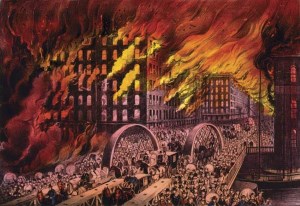
The Great Chicago Fire was a very devastating event in history. It killed many people and destroyed millions of dollars worth of property.
It was October 8th, 1871. A fire had started behind Patrick and Katherine O’Leary’s house from a lantern that was lit in the barn. Rumors say it was a cow that had knocked over the lit lantern. However, the Chicago City Council later put out a resolution discharging Katherine and her cow from being held responsible for the fire. Some even say that the fire was started by humans or an asteroid, but the mystery still lies unanswered of how the fire really began.
What is not a mystery is how quickly and easily the fire spread. This was a result of the dry summer Chicago had that year with only 2 ½ inches of rain falling between July and October. The firefighters responded to the scene of the fire quickly. However, they originally had gone to the wrong neighborhood. This immense mistake permitted the fire more freedom to spread and grow, creating a much more difficult task for the firefighters. As the fire was consuming wooden houses and private mansions, as well as commercial and industrial buildings, people were fleeing to the Randolph Street Bridge to try and escape the massive fire. The fire triggered an outburst of looting and lawlessness. Soldiers were called to Chicago, and they even affirmed martial law October 11th and did not lift it until many weeks later.
The fire affected many people in the area in a sorrowful and tragic way. Over three hundred people were killed from the destructive fire, one hundred thousand people were left homeless, and two hundred million dollars worth of property was destroyed.
Overall, the fire left Chicago in devastation. At the time there were only 324,000 people populating Chicago. This means that after the fire, more than a third of the population was either dead or homeless. This event influenced new laws stating what materials were allowed to be used to construct new buildings. The process was expensive, and many of the homeless people could not afford the cost of rebuilding. Though it was disastrous, it left Chicago with a clean slate in which architects were able to design beautiful skyscrapers and a more modern city. They also started to use materials such as terra-cotta, brick, limestone, and marble, making Chicago one of the most fireproof cities in the nation. All-in-all, The Great Chicago Fire is named one of the “most spectacular events of the nineteenth century” by Chicagohs.org because it truly was unforgettable.
[Sources:
chicagohs.org
;
history.com; Smithsonian Magazine; National Geographic
]
This story was originally published in the
Janesville Free Press
.

